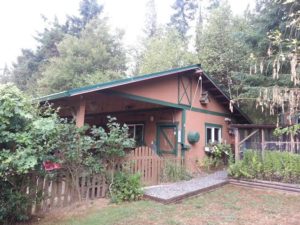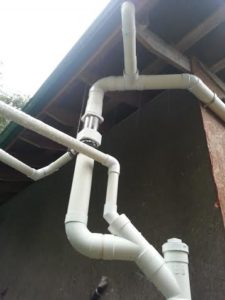We live in a wonderfully mild climate, but the downside of those long, hot and dry summers is that there is tremendous stress on the water table. When Mount Arrowsmith has a low snow load, all of the communities downstream feel the impact. We have access to a shared well in the area, but were concerned about stress on the well over time. So what do you do when the situation down there in the ground is uncertain?

We looked up instead. After all, we do live in a rainforest! The catch is that most of that rain falls in the winter, so the trick is to capture it while it’s plentiful and store it for the times that it isn’t. An emergency cistern was already on the property, and it was able to be adapted to a comprehensive water system with the help of Earthsmart Solutions, a fantastic local company.
Our barn and stable areas have oversized metal roofs, perfect for water collection. When the water falls, it runs down those roofs and into the gutters, which have filtered exits to control debris. We have large trees overhead, and it can be a challenge to keep the needles and pollen outside the system, but the gutters are screened and then connect to food grade PVC piping, which creates a closed system.

Those pipes come together at the back of the barn, feeding into one large pipe that is connected to a large WISY filter. This uses the centrifugal force created by the falling water’s downward motion to filter out debris in a basket-like structure to ensure that only clean water continues further. The excess water and debris move into a weeping tile network that is taken into the fields towards the apple orchard.
From the basket, the water moves into one of four 2500 gallon cisterns that are linked together so that the water levels will automatically equalize with water gain and loss. The tanks are partially buried and partially exposed, and have independent valves so that they can be individually turned on or off for emergencies or for maintenance. This offers us 10,000 gallons of usage and storage, with an additional 2,500 unfiltered gallons on a separate pump exclusively for garden irrigation.
The water is then pumped into our water locker by a pump and pressure tank system, and then moves directly into the house in the same way that well water does. Because I just happen to have a parent in the instrumentation business, we also have the added advantage of a precision water meter that allows us to track our usage over time. How lucky is that?

Once the water arrives in the house, it must be treated for microbes and pathogens. All water systems, whether municipal or rural wells, must have treatment processes. Usually we don’t see them though, as city water is processed in bulk at a facility that we don’t generally have any interaction with. It’s very interesting to see firsthand how very simple and how very complicated our civic utility systems really are. They work the same way that ours does, but on a huge scale.
Inside the house, two successive carbon particulate filters remove any particles that might be left in the water after initial filtration, and then the water passes through an ultraviolet system that finishes the purification system. The end result? Pure, clean, crystal clear drinking water.
Here on the west coast, our water pH tends to the acidic, so in order to make it absolutely perfect, we would need to correct it by adding that additional step. But why fuss over it? If you’ve ever washed your hair from a rain barrel, you’ll know how wonderfully alive this water feels.
Doing this project has been an enlightening experience, and we have an entirely new awareness of how precious every drop of water really is. This is true no matter where and how we live, and seeing it right in front of us has been invaluable. We rejoice in every drop that comes out of the faucet… and have a whole new appreciation for rainy days.
Life isn’t about waiting for the storm to pass…
It’s about learning to dance in the rain.
– Anonymous
